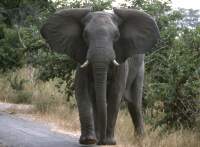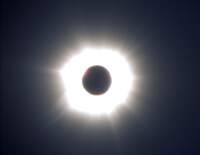
The last minutes
before 2nd contact.
|

Only a few seconds
til 2nd contact.
|

The glas filter
is removed and a ...
|

sequence of 2 images
per second ...
|

is started ...
|

to capture the ...
|

shrinking sickle ...
|

of the sun.
|

Some Bailey's Beads ...
|

with a Diamond Ring ...
|

become visible.
|

A few moments later ...
|

only the chromosphere ...
|

remains and ...
|

dominates the image.
|

In the closeup
the filamentary network of the protuberances are visible.
|

Then the exposure time ...
|

was increased ...
|

by 2 steps ...
|

for each consecutive ...
|

image until ...
|

30 sec. were reached.
This time around midtotality
was used for visual observing with 10x50 binoculars and a 4"-Astroscan
telescope provided by Tom Pfleger (Thanks for these great sights,
Tom).
|

After a programmable timer announced
the last 10 seconds of totality ...
|

a new sequence ...
|

of 1/250 sec. ...
|

exposures were started ...
|

to document the 3rd contact ...
|

up to the films end.
|

Beginning with this image ...
|

the Sigma APO 170-500 mm lens
...
|

was used with a focal length ...
|

of 500 mm @ f/8.0.
|
|

This happens, when a long duration
exposure lasts after the 3rd contact.
|

A fine Diamond ring finished the
series of images of the 2001 eclipse.
|

The view throug a Peleng 8mm fish
eye lens during totality.
|

A fish eye image with 7 h exposure
time. In the middle is Mars, Venus and the Moon are rising in the
east (left) behind trees.
Because of dew the trails of the stars become dimmer to the right.
This image is from the camp ground of Lochinvar NP.
|

This image of my equipment was
taken after the eclipse as you can see from the bottle of fine zambian
MOSI beer.
|

After the eclipse: the compulsory
group picture of 14 happy german amateur astronomers and the 2 zambian
scouts form ZAWA.
|
Besides the eclipse we stayed
3 weeks in Zambia and visited four National Parks and the Victoria
Falls:
|

The Main Falls, where an umbrella
isn't enough.
|

Only from a helicopter the full
extent of the Vic Falls can be seen.
|

The largest variety of animals
...
|

were seen in the
Livingstone NP:
|

zebras, buffalos, 4 of the 5 rhinos
living in Zambia, ...
|

giraffe and ...
|

elephants crossing the road.
|

Also impressive: a sunset cruise
on the mighty Zambezi.
|

This huge baobab tree is in ...
|

Lochinvar NP, famous for its birds
and antelopes.
|

Here we stayed for two nights.
|

A scene in Mumbwa, on our way
to ...
|

the Kafue NP. First we stayed
in a camp at the Kafue river ...
|

with many hippos lying in the
river and fresh lion marks only 100 m from our tents.
|

This is a typical dirt track in
Kafue NP. We drove more than 100 km due north from the tarmac road
to reach our next camp site ...
|

in the middle of the Busanga Floodplains.
Here we saw ...
|

many birds as eagles and marabus.
|

This grasshopper visited us in
our eclipse camp.
|

After 2 days back in civilisatin
in Lusaka we headed for the Lower Zambezi NP, ...
|

where we stayed for 4 days just
outside the park at the Chongwe River Camp.
|

On the other bank of the small
Chongwe river crocodiles, ...
|

elephants and hippos ...
|

showed up from their best side.
|
|

On the way back to
Lusaka we made an excursion to the Kariba Dam near Siavonga. Here you
can see me at the 128 m high crest of the dam.
|

Our last hours in
Lusaka we spent relaxed at the Vineyard
Lodge, which has always been a pleasant home when we stayed there
(6 nights at all during 4 stays).
|

The last view back
to a wonderful country which we all appreciated during these 3 weeks.
|































































